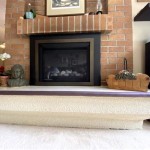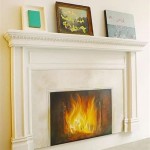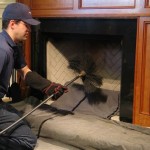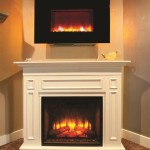White Wood Fireplace Designs: A Comprehensive Guide
A fireplace serves as a focal point in any room, offering warmth, ambiance, and a touch of elegance. When considering a fireplace design, the choice of material and color plays a significant role in complementing the overall aesthetic of the space. White wood fireplaces have gained considerable popularity due to their versatility, clean appearance, and ability to seamlessly integrate into various interior design styles. This article delves into the intricacies of white wood fireplace designs, exploring their advantages, different styles, design considerations, and maintenance.
The Appeal of White Wood Fireplaces
White, as a color, possesses inherent qualities that make it a desirable choice for fireplace surrounds. It represents purity, cleanliness, and simplicity, creating a bright and airy atmosphere. A white wood fireplace can visually expand a room, making it feel more spacious and inviting. Furthermore, white acts as a neutral backdrop, allowing other elements in the room, such as furniture, artwork, and accessories, to take center stage. The timeless nature of white ensures that the fireplace remains stylish and relevant, regardless of evolving trends.
Wood, as a material, brings warmth and texture to a space. The natural grain patterns and subtle variations in color add character and visual interest. When combined with white paint or stain, wood retains its inherent charm while acquiring a fresh and modern appeal. White wood fireplaces can be customized to suit various design preferences, ranging from traditional to contemporary.
Exploring Different Styles of White Wood Fireplaces
The versatility of white wood allows for a wide range of design styles to be achieved. Each style offers a unique aesthetic and caters to different architectural preferences.
Traditional White Wood Fireplaces: These fireplaces often feature intricate detailing, such as raised panels, fluted columns, and decorative moldings. The white finish enhances the classic elegance of the design, creating a timeless and sophisticated look. Traditional designs frequently incorporate a mantel shelf for displaying decorative items and family photos. The firebox surround is typically made of brick or stone, adding to the overall rustic charm.
Modern White Wood Fireplaces: Modern designs prioritize clean lines, simplicity, and functionality. White wood fireplaces in this style often feature a minimalist design with a sleek, unadorned mantel. The focus is on creating a streamlined appearance that complements the contemporary aesthetic of the room. Modern fireplaces may incorporate geometric shapes and unconventional materials, such as glass or metal, for added visual interest.
Rustic White Wood Fireplaces: For those seeking a more relaxed and natural look, rustic white wood fireplaces offer a perfect solution. These designs typically incorporate reclaimed wood or distressed finishes, creating a sense of warmth and character. The white finish complements the natural textures of the wood, enhancing its inherent beauty. Rustic fireplaces may feature exposed brick or stone accents, further emphasizing the natural aesthetic.
Farmhouse White Wood Fireplaces: Farmhouse style is characterized by its comfortable, inviting, and slightly nostalgic ambiance. White wood fireplaces in this style often incorporate shiplap paneling, a design element that adds texture and visual interest. The mantel shelf is typically made of reclaimed wood or features a simple, unadorned design. Farmhouse fireplaces may incorporate vintage-inspired details, such as antique hardware or decorative accents.
Key Design Considerations for White Wood Fireplaces
When designing a white wood fireplace, several factors must be considered to ensure a cohesive and aesthetically pleasing result.
Choosing the Right Shade of White: White is not a monolithic color; it encompasses a wide range of shades, each with its own unique undertones. Selecting the right shade of white is crucial for achieving the desired aesthetic. Warm whites, with yellow or cream undertones, create a cozy and inviting atmosphere. Cool whites, with blue or gray undertones, offer a more modern and sophisticated look. The choice of white should complement the existing color palette of the room and the overall design style.
Selecting the Appropriate Wood Type: The type of wood used for the fireplace surround can significantly impact its appearance and durability. Hardwoods, such as oak, maple, and cherry, are known for their strength and resistance to wear and tear. Softwoods, such as pine and cedar, are more affordable but may require additional protection against dents and scratches. The choice of wood should be determined by the desired aesthetic, budget, and level of maintenance required.
Mantel Design and Placement: The mantel serves as a focal point of the fireplace and offers an opportunity to showcase personal style. The design of the mantel should complement the overall style of the fireplace and the room. A simple, unadorned mantel is ideal for modern designs, while a more elaborate mantel with intricate detailing is suitable for traditional styles. The placement of the mantel should be proportionate to the size of the fireplace and the room. A mantel that is too large or too small can disrupt the overall balance of the design.
Firebox Surround Material: The material used for the firebox surround can significantly impact the overall aesthetic of the fireplace. Brick and stone are popular choices for traditional and rustic designs, adding texture and warmth to the space. Tile is a versatile option that can be customized to suit various styles, from modern to contemporary. Metal, such as stainless steel or copper, offers a sleek and modern look. The choice of firebox surround material should complement the overall design of the fireplace and the room.
Lighting Considerations: Proper lighting can enhance the visual appeal of the fireplace and create a warm and inviting atmosphere. Recessed lighting can be used to highlight the mantel and the decorative items displayed on it. Sconces can be installed on either side of the fireplace to provide ambient lighting. A decorative chandelier or pendant light can be hung above the fireplace to create a dramatic focal point. The choice of lighting should complement the overall style of the room and enhance the ambiance.
Maintaining a White Wood Fireplace
Maintaining a white wood fireplace involves regular cleaning and care to preserve its appearance and prevent damage. Dust and debris can accumulate on the surface of the wood, dulling the finish and creating a dirty appearance. Regular dusting with a soft cloth is essential for keeping the fireplace clean. For more stubborn dirt and grime, a mild soap solution can be used. It is important to avoid using harsh chemicals or abrasive cleaners, as these can damage the finish. Applying a protective sealant or wax can help to protect the wood from moisture and stains.
The firebox surround should also be cleaned regularly to remove soot and ash. Brick and stone can be cleaned with a wire brush and a mild soap solution. Tile can be cleaned with a tile cleaner. Metal can be cleaned with a metal polish. It is important to follow the manufacturer's instructions for cleaning each specific material.
Regular inspections should be conducted to identify any signs of damage, such as cracks, chips, or peeling paint. Minor repairs can be made with wood filler and touch-up paint. More extensive damage may require professional repair or replacement. By following these simple maintenance tips, a white wood fireplace can remain a beautiful and functional focal point in the home for many years to come.
Choosing the right firebox insert is crucial for both aesthetics and functionality. Gas inserts offer convenience and ease of use, while wood-burning inserts provide a traditional ambiance, bringing the crackling sound and scent of burning wood into the home. When pairing with a white wood surround, ensure the insert's design complements the overall style, whether prioritizing a sleek, modern look or a more rustic, traditional feel. Proper installation and ventilation are also critical safety considerations when selecting a fireplace insert.
The surrounding decor and furnishing of a room can greatly influence how a white wood fireplace is perceived. Consider incorporating colors and materials that contrast the white, such as dark woods or bold textiles, to create visual interest. Mirrors can also be strategically placed to reflect light and enhance the sense of spaciousness. Coordinate the style of the fireplace with furniture and accessories, whether through similar colors, textures, or design motifs, to achieve a cohesive and harmonious living space.

White Fireplace Mantels

53 Best Fireplace Mantel Designs To Ignite Your Creativity Living Room Decor White Mantels

28 White Brick Fireplace Ideas To Update Your Home Off Center

30 Stunning White Brick Fireplace Ideas

All White Wood Fireplace Paneling Carrara Marble Herringbone Mantel French Oak Brick Remodel Built Ins

53 Best Fireplace Mantel Designs To Ignite Your Creativity Classic White Mantels

28 White Brick Fireplace Ideas To Update Your Home Wall

36 Fireplace Decor Ideas Modern Mantel
:max_bytes(150000):strip_icc()/sandandsisal-bdc76ad938a44d28ae9e23ef6c9fa331.jpg?strip=all)
17 Diy Fireplace Mantel Plans

30 Stunning White Brick Fireplace Ideas Part 1 Wash
Related Posts








